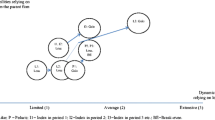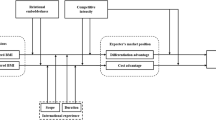Abstract
Past empirical studies have yielded ‘no consistent relationship between strategy adaptation and firm performance’. These inconclusive results may be partially due to a bias amongt managers to under-adapt their host market strategies. This paper presents the results of the second stage of a longitudinal study identifying a potential status quo bias among exporters, leading to systematic under-adaptation.


Similar content being viewed by others
References
Alashban, A.A., Hayes, L.A., Zinkhan, G.M. and Balazs, A.L. (2002) ‘International brand-name standardization/adaptation: antecedents and consequences’, Journal of International Marketing 10(3): 22–48.
Albaum, G. and Tse, D.K. (2001) ‘Adaptation of international marketing strategy components, competitive advantage, and firm performance: a study of Hong Kong exporters’, Journal of International Marketing 9(4): 59–81.
Anderson, C.J. (2003) ‘The psychology of doing nothing: forms of decision avoidance result from reason and emotion’, Psychological Bulletin 129(1): 139–167.
Baalbaki, I.B. and Malholtra, N.K. (1995) ‘Standardization vs customization in International Marketing: an investigation using bridging conjoint analysis’, Journal of the Academy of Marketing Science 23(3): 182–194.
Bartlett, C.A. and Ghoshal, S. (1987) ‘Managing across borders: new strategic requirements’, Sloan Management Review 28(4): 7–17.
Bentler, P.M. (1993) EQS: Structural Equations Program Manual, BMDP Statistical Software Inc.: Los Angeles.
Boddewyn, J.J., Soehl, R. and Picard, J. (1986) ‘Standardization in international marketing: is Ted Levitt in fact right?’ Business Horizons 29(6): 69–75.
Buatsi, S.N. (1986) ‘Organizational adaptation to international marketing’, International Marketing Review 3(4): 17–26.
Buzzell, R.D. (1968) ‘Can you standardize multinational marketing?’ Harvard Business Review 46(6): 102–113.
Cavusgil, S.T. (1984) ‘Differences among exporting firms based on their degree of internationalization’, Journal of Business Research 12(2): 195–208.
Cavusgil, S.T. and Kirpalani, V.H. (1993) ‘Introducing products into export markets: success factors’, Journal of Business Research 27(1/2): 1–15.
Cavusgil, S.T. and Zou, S. (1994) ‘Marketing strategy–performance relationship: an investigation of the empirical link in export market ventures’, Journal of Marketing 58(1): 1–21.
Cavusgil, S.T., Zou, S. and Naidu, G.M. (1993) ‘Product and promotion adaptation in export ventures: an empirical investigation’, Journal of International Business Studies 24(3): 479–506.
Cooper, R.G. and Kleinschmidt, E.J. (1985) ‘The impact of export strategy on export sales performance’, Journal of International Business Studies 16(1): 37–55.
Cyert, R.M. and March, J.G. (1963) A Behavioural Theory of the Firm, Prentice-Hall: Englewood Cliffs, NJ.
Diamantopoulos, A. and Inglis, C. (1988) ‘Identifying differences between high and low involvement exporters’, International Marketing Review 5(2): 52–60.
Donnelly Jr., J.H. and Ryans Jr., J.K. (1969) ‘Standardized global advertising’, Journal of Marketing 33(2): 57–60.
Douglas, S.P. and Wind, Y. (1987) ‘The myth of globalization’, Columbia Journal of World Business 22(4): 19–29.
Dow, D. (2001) ‘The adaptation of host market positioning strategies: empirical evidence on Australian Exporters’, Journal of International Marketing 9(3): 41–62.
Du Preez, J.P., Diamantopoulos, A. and Schlegelmilch, B.B. (1994) ‘Product standardization and attribute saliency: a three country empirical comparison’, Journal of International Marketing 2(1): 7–28.
Dunn, S.W. (1976) ‘Effect of national identity on multinational promotion strategy in Europe’, Journal of Marketing 40(4): 50–57.
Gomez-Mejia, L.R. (1988) ‘The role of human resources strategy in export performance: a longitudinal study’, Strategic Management Journal 9(5): 493–505.
Green, R.T., Cunningham, W.H. and Cunningham, I.C. (1975) ‘The effectiveness of standardized global advertising’, Journal of Advertising 4(3): 25–30.
Hair Jr., J.F., Anderson, R.E., Tatham, R.L. and Black, W.C. (1992) Multivariate Data Analysis, 3rd edn. Macmillan: New York.
Hannan, M. and Freeman, J. (1984) ‘Structural inertia and organizational change’, American Sociological Review 49(2): 149–164.
Hannan, M.T. and Freeman, J. (1977) ‘The population ecology of organizations’, American Journal of Sociology 82(5): 929–964.
Hofer, C.W. (1975) ‘Towards a contingency theory of business strategy’, Academy of Management Journal 18(4): 784–810.
Johanson, J. and Vahlne, J.-E. (1977) ‘The internationalization process of the firm: a model of knowledge development and increasing foreign commitments’, Journal of International Business Studies 8(1): 23–32.
Kahneman, D., Knetsch, J.L. and Thaler, R.H. (1990) ‘Experimental tests of the endowment effect and the Coase theorem’, Journal of Political Economy 98(6): 1325–1348.
Knetsch, J.L. (1989) ‘The endowment effect and evidence of nonreversible indifference curves’, American Economic Review 79(5): 1277–1284.
Knetsch, J.L. and Sinden, J.A. (1984) ‘Willingness to pay and compensation demanded: experimental evidence of an unexpected disparity in measures of value’, Quarterly Journal of Economics 99(3): 507–522.
Koh, A.C. and Robicheaux, R.A. (1988) ‘Variations in export performance due to differences in export marketing strategy: implications for industrial marketers’, Journal of Business Research 17(3): 249–258.
Lawrence, P.R. and Lorsch, J.W. (1967) Organization and Environment: Managing Differentiation and Integration, Harvard University Press: Boston, MA.
Leonidou, L.C., Katsikeas, C.S. and Samiee, S. (2002) ‘Marketing strategy determinants of export performance: a meta-analysis’, Journal of Business Research 55(1): 51–67.
Levitt, T. (1983) ‘The globalization of markets’, Harvard Business Review 61(3): 92–102.
Loewenstein, G.F. (1988) ‘Frames of mind in intertemporal choice’, Management Science 34(2): 200–214.
March, J.G. and Simon, H.A. (1958) Organizations, Wiley: New York.
McDougall, P.P., Oviatt, B.M. and Shrader, R.C. (2003) ‘A comparison of international and domestic new ventures’, Journal of International Entrepreneurship 1(1): 59–82.
McDougall, P.P., Shane, S. and Oviatt, B.M. (1994) ‘Explaining the formation of international new ventures: the limits of the theories from international business research’, Journal of Business Venturing 9(6): 469–487.
Mueller, B. (1991) ‘Multinational advertising: factors influencing the standardised vs specialised approach’, International Marketing Review 8(1): 7–18.
O’Donnell, S. and Jeong, I. (2000) ‘Marketing standardization within global industries’, International Marketing Review 17(1): 19–34.
Oviatt, B.M. and McDougall, P.P. (1994) ‘Toward a theory of international new ventures’, Journal of International Business Studies 25(1): 45–63.
Ozsomer, A., Bodur, M. and Cavusgil, S.T. (1991) ‘Marketing standardisation by multinationals in an emerging market’, European Journal of Marketing 25(12): 50–64.
Ozsomer, A. and Prussia, G.E. (2000) ‘Competing perspectives in international marketing strategy: contingency and process models’, Journal of International Marketing 8(1): 27–50.
Perlmutter, H.V. (1969) ‘The tortuous evolution of the multinational corporation’, Columbia Journal of World Business 4(1): 9–18.
Prahalad, C.K. and Doz, Y.L. (1987) The Multinational Mission: Balancing Local Demands and Global Vision, The Free Press: New York.
Puxty, A.G. (1979) ‘Some evidence concerning cultural differentials in ownership policies of overseas subsidiaries’, Management International Review 19(2): 39–52.
Romanelli, E. and Tushman, M.L. (1986) ‘Inertia, environments and strategic choice: a quasi-experimental design for longitudinal research’, Management Science 32(5): 608–621.
Ronkainen, I.A. (1983) ‘Product development in the multinational firm’, International Marketing Review 1(2): 24–30.
Roth, K. (1992a) ‘Implementing international strategy at the business unit level: the role of managerial decision-making characteristics’, Journal of Management 18(4): 769–789.
Roth, K. (1992b) ‘International configuration and coordination archetypes for medium-sized firms in global industries’, Journal of International Business Studies 18(3): 533–549.
Roth, K. and Morrison, A.J. (1990) ‘An empirical analysis of the integration-responsiveness framework in global industries’, Journal of International Business Studies 16(4): 541–564.
Samiee, S. and Roth, K. (1992) ‘The influence of global marketing standardization on performance’, Journal of Marketing 56(2): 1–12.
Samuelson, W. and Zeckhauser, R. (1988) ‘Status quo bias in decision making’, Journal of Risk and Uncertainty 1(1): 7–59.
Seifert, B. and Ford, J. (1989) ‘Are exporting firms modifying their product, pricing and promotion policies?’ International Marketing Review 6(6): 53–68.
Shaver, J.M. (1998) ‘Accounting for endogeneity: when assessing strategy performance: does entry mode choice affect FDI survival?’ Management Science 44(4): 571–585.
Shoham, A. (1996) ‘Marketing mix standardization: determinants of export performance’, Journal of Global Marketing 10(2): 53–73.
Shoham, A. (1998) ‘Export performance: a conceptualization and empirical assessment’, Journal of International Marketing 6(3): 59–81.
Shoham, A. (1999) ‘Bounded rationality, planning, standardization of international strategy, and export performance: a structural model examination’, Journal of International Marketing 7(2): 24–50.
Shoham, A. and Albaum, G. (1994) ‘The effects of transfer of marketing methods on export performance: an empirical examination’, International Business Review 3(3): 219–241.
Solberg, C.A. (2000) ‘Standardization or adaptation of international marketing mix: the role of the local subsidiary/representative’, Journal of International Marketing 8(1): 78–98.
Solberg, C.A. (2002) ‘The perennial issue of adaptation or standardization of international marketing communication: organizational contingencies and performance’, Journal of International Marketing 10(3): 1–21.
Thach, S.V. and Axinn, C.A. (1991) ‘Pricing and financing practices of industrial exporting firms’, International Marketing Review 8(1): 32–46.
Thaler, R.H., Tversky, A., Kahneman, D. and Schwartz, A. (1997) ‘The effect of myopia and loss aversion on risk taking an experimental test’, Quarterly Journal of Economics 112(2): 647–659.
Theodosiou, M. and Katsikeas, C.S. (2001) ‘Factors influencing the degree of international pricing strategy standardization of multinational corporations’, Journal of International Marketing 9(3): 1–18.
Tookey, D.A. (1964) ‘Factors associated with success in exporting’, Journal of Management Studies 1(1): 48–66.
Venkatraman, N. (1989) ‘The concept of fit in strategy research: toward verbal and statistical correspondence’, Academy of Management Review 14(3): 423–444.
Venkatraman, N. and Prescott, J.E. (1990) ‘Environment–strategy coalignment: an empirical examination of its performance implications’, Strategic Management Journal 11(1): 1–23.
Zou, S. and Cavusgil, S.T. (2002) ‘The GMS: a broad conceptualization of global marketing strategy and its affect on firm performance’, Journal of Marketing 66(4): 40–56.
Zou, S., Taylor, C.R. and Osland, G.E. (1998) ‘The EXPERF scale: a cross-national generalized export performance measure’, Journal of International Marketing 6(3): 37–58.
Acknowledgements
I thank JIBS Departmental Editor, Professor J. Myles Shaver and the two anonymous JIBS reviewers for their comments, insights and suggestions.
Author information
Authors and Affiliations
Corresponding author
Additional information
Accepted by J Myles Shaver, Departmental Editor, 24 October 2003. This paper has been with the author for two revisions.
Rights and permissions
About this article
Cite this article
Dow, D. Adaptation and performance in foreign markets: evidence of systematic under-adaptation. J Int Bus Stud 37, 212–226 (2006). https://doi.org/10.1057/palgrave.jibs.8400189
Received:
Revised:
Accepted:
Published:
Issue Date:
DOI: https://doi.org/10.1057/palgrave.jibs.8400189















